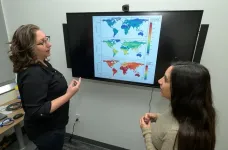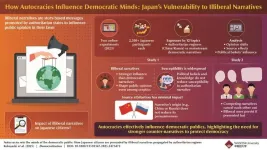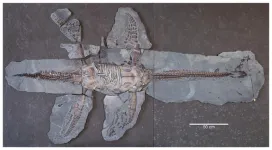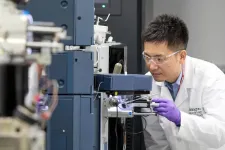(Press-News.org) PULLMAN, Wash. — A new artificial intelligence tool could aid in limiting or even prevent pandemics by identifying animal species that may harbor and spread viruses capable of infecting humans.
Created by Washington State University researchers, the machine learning model analyzes host characteristics and virus genetics to identify potential animal reservoirs and geographic areas where new outbreaks are more likely to occur. The model focuses on orthopoxviruses — which includes the viruses that cause smallpox and mpox.
The researchers recently published a study on their work using the model in the journal Communications Biology. Their findings could help scientists anticipate emerging zoonotic threats and, importantly, be adapted for other viruses.
“Nearly three-quarters of emerging viruses that infect humans come from animals,” said Stephanie Seifert, an expert in viral emergence and cross species transmission and an assistant professor in the WSU College of Veterinary Medicine’s Paul G. Allen School for Global Health who helped to lead the project. “If we can better predict which species pose the greatest risk, we can take proactive measures to prevent pandemics.”
The model identified Southeast Asia, equatorial Africa, and the Amazon as potential hotspots for orthopoxvirus outbreaks. These regions not only have high concentrations of potential hosts but also overlap with areas where smallpox vaccination rates are low. While the smallpox vaccine provides cross-protection against other orthopoxviruses, vaccination efforts stopped after smallpox was eradicated in 1980.
The study also identified several animal families as likely hosts for mpox, including rodents, cats, canids (dogs and related species), skunks, mustelids (weasels and otters) and raccoons. The model correctly excluded rats, which have been shown in laboratory studies to be resistant to mpox infection.
Katie Tseng, a veterinary medicine graduate student and the study’s first author, noted the model not only demonstrated higher predictive accuracy than previous models, but it can be useful in predicting hosts for other viruses as well.
“While we used the model specifically for orthopoxviruses, we can also go in a lot of different directions and start fine tuning this model for other viruses,” she said.
Pilar Fernandez, a disease ecologist and assistant professor in the Allen School who helped to lead the project with Seifert, said previous machine learning models used to predict potential hosts for orthopoxviruses relied on the ecological traits of animals, such as habitat and diet, and other characteristics that influence their interactions with the environment, such as resource use and survival. While effective, these models ignored a crucial part of the equation – the genetic makeup of the viruses.
“Previous models were more based on the characteristics of the host, but we wanted to add the other side of the story, the characteristics of the viruses,” Fernandez said. “Our model improves the accuracy of host predictions and provides a clearer picture of how viruses may spread across species.”
Orthopoxviruses typically cause small, localized outbreaks, but recent events, including the global spread of mpox in 2022, have raised concerns about these viruses establishing new endemic areas and spreading through new animal reservoirs.
Identifying possible reservoirs is key to anticipating spillover events, however, accomplishing that through traditional field sampling is a resource-intensive and impractical endeavor. The new model simplifies that task and can be used to target wildlife surveillance efforts.
“If you are looking for the reservoir for mpox virus in Central Africa, that’s one of the most biodiverse places on Earth, so where do you start?” Seifert said. “If we can use these machine learning models to help us prioritize sampling efforts, then that’s going to be really beneficial in identifying where these viruses are coming from and in understanding the risks they pose.”
The research team also included Heather Koehler, an assistant professor in the School of Molecular Biosciences who has extensively studied mpox. Daniel J. Becker, University of Oklahoma; Rory Gibb, University College London; and Collin Carlson, Yale University, also contributed as members of the Viral Emergence Research Institute, a collaborative network of scientists studying host-virus interactions to predict virus spread on a global scale that is funded by the National Science Foundation. The group includes experts in data science, computational biology, virology, ecology, and evolutionary biology.
END
WSU researchers develop machine learning model to predict virus reservoirs
2025-03-31
ELSE PRESS RELEASES FROM THIS DATE:
Do authoritarian narratives shape Japanese public opinion?
2025-03-31
An authoritarian regime is a type of government system where power is restricted in the hands of a single leader or a group, limiting the participation of citizens in decision-making. As authoritarian states like China and Russia intensify their global information campaigns, a new study highlights Japan’s vulnerability to illiberal narratives. This research, led by Professor Tetsuro Kobayashi of Waseda University, Research Associate Yuan Zhou of Kobe University, Ph.D. student Lungta Seki of Koç University, and Professor Asako Miura of Osaka University, was published online on March 12, ...
New plesiosaur discovery sheds light on early Jurassic evolution and plausible endemism
2025-03-31
A nearly complete specimen of Plesiopterys wildi from Germany provides fresh insights into plesiosaur diversity and regional specialisation
A newly described plesiosaur fossil from southern Germany is providing crucial evidence about the diversification of these ancient marine reptiles during the Early Jurassic. Published in PeerJ Life and Environment, the study details the discovery and analysis of an exceptionally well-preserved Plesiopterys wildi specimen, which offers new clues about the evolution and geographic distribution of plesiosaurs in Europe nearly 180 million years ago.
Unearthed ...
Chance discovery improves stability of bioelectronic material used in medical implants, computing and biosensors
2025-03-31
HOUSTON – (March 31, 2025) – A chance discovery led a team of scientists from Rice University, University of Cambridge and Stanford University to streamline the production of a material widely used in medical research and computing applications.
For over two decades, scientists working with a composite material known as PEDOT:PSS, used a chemical crosslinker to make the conductive polymer stable in water. While experimenting with ways to precisely pattern the material for applications in biomedical optics, Siddharth Doshi, a doctoral student at Stanford collaborating with Rice materials scientist Scott Keene, ...
Using artificial intelligence to calculate the heart’s biological age through ECG data predicts increased risk of mortality and cardiovascular events
2025-03-31
Vienna, Austria- 31 March 2025 - While everybody’s heart has an absolute chonological age (as old as that person is), hearts also have a theoretical ‘biological’ age1 that is based on how the heart functions. So someone who is 50 but has poor heart health could have a biological heart age of 60, while someone of 50 with optimal heart health could have a biological heart age of 40.
Researchers presenting a new study today at EHRA 2025, a scientific congress of the European Society of Cardiology (ESC), demonstrated that by using artificial intelligence (AI) to analyse standard ...
“She loves me, she loves me not”: physical forces encouraged evolution of multicellular life, scientists propose
2025-03-31
WOODS HOLE, Mass. -- Humans like to think that being multicellular (and bigger) is a definite advantage, even though 80 percent of life on Earth consists of single-celled organisms – some thriving in conditions lethal to any beast.
In fact, why and how multicellular life evolved has long puzzled biologists. The first known instance of multicellularity was about 2.5 billion years ago, when marine cells (cyanobacteria) hooked up to form filamentous colonies. How this transition occurred and the benefits it accrued to the cells, though, is less than clear.
This week, a study originating from the Marine Biological Laboratory (MBL) presents a striking example of cooperative ...
The hidden superconducting state in NbSe₂: shedding layers, gaining insights
2025-03-31
Researchers have discovered an unexpected superconducting transition in extremely thin films of niobium diselenide (NbSe₂). Published in Nature Communications, they found that when these films become thinner than six atomic layers, superconductivity no longer spreads evenly throughout the material, but instead becomes confined to its surface. This discovery challenges previous assumptions and could have important implications for understanding superconductivity and developing advanced quantum technologies.
Researchers at the Hebrew University of Jerusalem have made a surprising discovery about how superconductivity ...
New AI models possible game-changers within protein science and healthcare
2025-03-31
Researchers have developed new AI models that can vastly improve accuracy and discovery within protein science. Potentially, the models will assist the medical sciences in overcoming present challenges within, e.g. personalised medicine, drug discovery, and diagnostics.
In the wake of broadly available AI tools, most technical and natural sciences fields are advancing rapidly. This is particularly true in biotechnology, where AI models power breakthroughs in drug discovery, precision medicine, gene editing, food security, and many other research areas.
One sub-field is proteomics – the study of proteins on a large scale – where ...
Highly accurate blood test diagnoses Alzheimer’s disease, measures extent of dementia
2025-03-31
A newly developed blood test for Alzheimer’s disease not only aids in the diagnosis of the neurodegenerative condition but also indicates how far it has progressed, according to a study by researchers at Washington University School of Medicine in St. Louis and Lund University in Sweden.
Several blood tests for Alzheimer’s disease are already clinically available, including two based on technology licensed from WashU. Such tests help doctors diagnose the disease in people with cognitive symptoms, but do not indicate the ...
Mind the seismic gap: Understanding earthquake types in Guerrero, Mexico
2025-03-31
Plate temperature and water release can explain the occurrence of different types of earthquakes in Guerrera, Mexico. The Kobe University simulation study also showed that the shape of the Cocos Plate is responsible for a gap where earthquakes haven’t occurred for more than a century. The results are important for accurate earthquake prediction models in the region.
Where one tectonic plate is pushed down by another, the resulting stress is released in various tectonic events. There are catastrophic megathrust earthquakes, unnoticeable “slow slip events,” and continuous low-frequency “tectonic tremors,” and knowing ...
One hour’s screen use after going to bed increases your risk of insomnia by 59%, scientists find
2025-03-31
Scientists have found another reason to put the phone down: a survey of 45,202 young adults in Norway has discovered that using a screen in bed drives up your risk of insomnia up by 59% and cuts your sleep time by 24 minutes. However, social media was not found to be more disruptive than other screen activities.
“The type of screen activity does not appear to matter as much as the overall time spent using screens in bed,” said Dr Gunnhild Johnsen Hjetland of the Norwegian Institute of Public Health, ...







